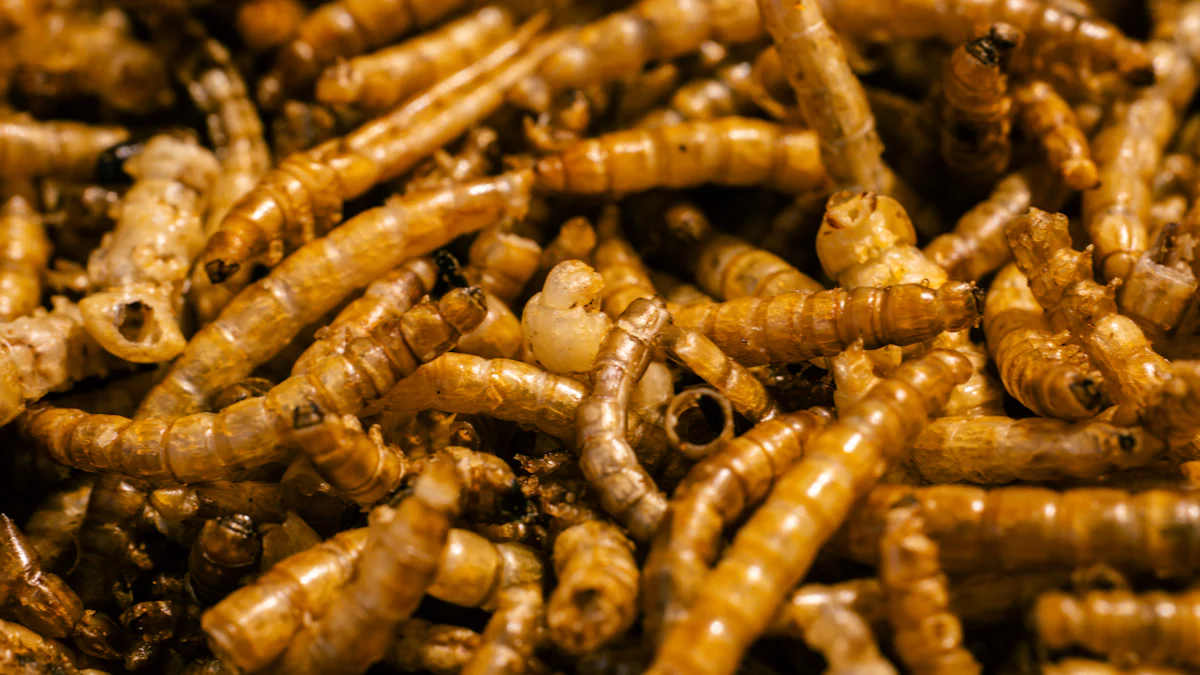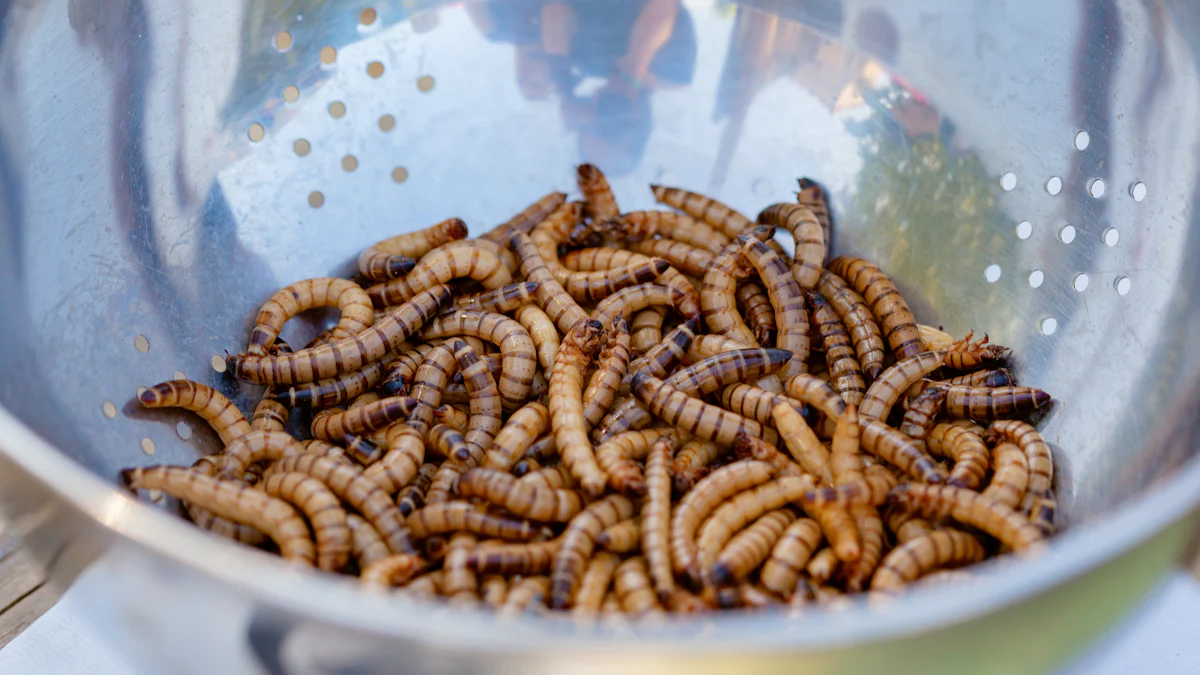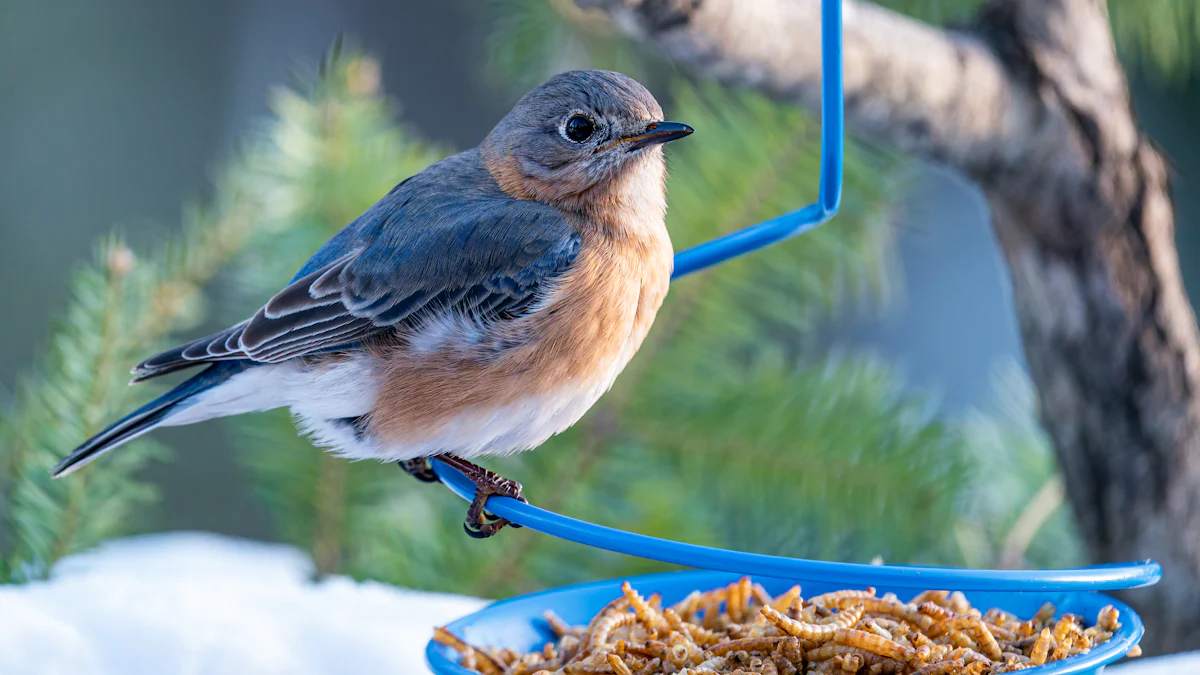
Have you ever wondered how to make your yard a haven for wild birds? Offering mealworms for birds is a simple way to do it. These little critters pack a punch of nutrition, helping birds stay healthy and strong. Plus, they’ll attract a variety of feathered friends to brighten your day!
Key Takeaways
- Mealworms are healthy food for birds, full of protein and nutrients.
- Feeding mealworms brings many bird types to your yard. This makes birdwatching fun and helps nature.
- You can give mealworms all year. They help birds during breeding, travel, and tough weather.
Why Feed Mealworms to Wild Birds?
Nutritional benefits of mealworms
Mealworms are like a superfood for birds. They’re packed with protein, which helps birds build strong muscles and feathers. Protein is especially important for young birds as they grow. Mealworms also contain healthy fats that give birds the energy they need to fly, forage, and stay active. Plus, they’re rich in essential nutrients like potassium and iron. These nutrients support overall health, keeping birds strong and vibrant. When you offer mealworms for birds, you’re giving them a boost that helps them thrive.
Supporting birds during breeding and migration
Birds face tough challenges during breeding and migration seasons. Breeding birds need extra energy to care for their young. Migrating birds travel long distances and burn a lot of calories along the way. Mealworms provide the fuel they need to survive these demanding times. By adding mealworms to your yard, you’re helping birds stay healthy when they need it most. It’s a small gesture that makes a big difference in their lives.
Attracting diverse bird species to your yard
Want to see more birds in your yard? Mealworms are a great way to do it. Many bird species love mealworms, from bluebirds to robins to chickadees. Offering this tasty treat can bring a variety of feathered visitors to your feeders. You might even spot some species you’ve never seen before! Mealworms for birds are like a magnet, drawing in a colorful mix of wildlife to brighten your outdoor space.
What Are the Benefits of Mealworms for Birds?
High protein content for energy and growth
Mealworms are a powerhouse of protein, making them an excellent food choice for birds. Protein is essential for muscle development, feather growth, and overall health. When birds consume mealworms, they get the energy they need to stay active and strong. This is especially important for young birds that are still growing and for adult birds during demanding times like breeding or migration. By offering mealworms, you’re giving birds the fuel they need to thrive.
Suitable for feeding in all seasons
One of the best things about mealworms is their versatility. You can feed them to birds year-round. In spring and summer, they help birds during nesting and raising their chicks. In fall, they provide energy for migration. During winter, when natural food sources are scarce, mealworms become a lifeline for many species. Whether it’s hot or cold outside, mealworms for birds are always a reliable option to keep them well-fed and healthy.
Encourages natural foraging behavior
Mealworms mimic the insects birds naturally hunt in the wild. When you offer mealworms, you encourage birds to engage in their natural foraging instincts. This keeps them active and mentally stimulated. You might notice birds hopping around your yard, searching for these tasty treats. It’s a joy to watch and a great way to support their natural behaviors while providing them with a nutritious snack.
Which Birds Eat Mealworms?

Common backyard birds that eat mealworms
You’ll be amazed at how many backyard birds enjoy mealworms. Bluebirds are some of the biggest fans. They’ll flock to your yard if you offer this tasty snack. Robins, wrens, and chickadees also love mealworms. Even woodpeckers and nuthatches can’t resist them. If you’re lucky, you might even spot a warbler or two stopping by for a quick bite. Mealworms are a universal favorite, making them a great choice for attracting a variety of birds to your feeders.
Seasonal changes in bird species
The types of birds that visit your yard for mealworms can change with the seasons. In spring and summer, you’ll likely see nesting birds like bluebirds and robins. They need the extra protein to feed their growing chicks. During fall migration, you might notice different species passing through, such as warblers or thrushes. Winter brings its own set of visitors, like juncos and sparrows, who rely on mealworms when insects are scarce. Keep an eye out—you never know who might show up next!
Identifying birds that enjoy mealworms
Not sure which birds are enjoying the mealworms in your yard? Grab a pair of binoculars and watch closely. Look for birds with sharp beaks or those that hop around feeders. Bluebirds often perch nearby before swooping in. Robins and wrens tend to forage on the ground. If you’re still unsure, try snapping a photo and using a bird identification app. It’s a fun way to learn more about your feathered visitors while offering them a nutritious treat.
How Do I Feed Mealworms to Wild Birds?

Choosing the right feeder for mealworms
Picking the right feeder makes a big difference when offering mealworms to birds. You’ll want something that keeps the mealworms contained but still accessible to your feathered visitors. A dish-style feeder works well for live or dried mealworms. Look for one with raised edges to prevent the mealworms from spilling out. If squirrels or larger birds are a problem, consider a feeder with a cage or dome to keep them out. Hanging feeders are also a great option, especially if you want to keep the mealworms off the ground and away from pests.
Best practices for placing mealworms in your yard
Where you place the feeder matters just as much as the feeder itself. Birds feel safer when feeders are near shrubs or trees, where they can quickly hide if needed. Avoid placing feeders in wide-open spaces or areas with heavy foot traffic. If you’re feeding live mealworms, try setting the feeder on a flat surface like a table or platform. This mimics the natural way birds forage for insects. Keep the feeder clean and move it occasionally to prevent attracting unwanted pests.
How much to feed and the best times to offer mealworms
Start small when feeding mealworms. A tablespoon or two is usually enough for a day. Birds will eat what they need, and you can adjust the amount based on how quickly they finish. Early morning is the best time to offer mealworms since birds are most active then. If you’re feeding during breeding or migration seasons, consider adding a second feeding in the late afternoon. This ensures the birds get enough energy during these demanding times.
Should I Use Live or Dried Mealworms?
Advantages and disadvantages of live mealworms
Live mealworms are a favorite among birds. They wiggle and move, which makes them irresistible to your feathered friends. Offering live mealworms can attract more birds to your yard, especially insect-eating species like bluebirds and wrens. They’re also packed with moisture, which helps keep birds hydrated, especially during hot weather.
However, live mealworms require a bit more effort on your part. You’ll need to store them properly, usually in a cool place like a refrigerator, to keep them alive. They can also escape if not handled carefully. If you’re squeamish about handling live insects, this might not be the best option for you.
Advantages and disadvantages of dried mealworms
Dried mealworms are super convenient. You don’t have to worry about keeping them alive or dealing with wriggling insects. They’re easy to store and have a long shelf life, making them a hassle-free option. You can simply scoop out the amount you need and place them in your feeder.
On the downside, dried mealworms lack the moisture content of live ones. Birds may need to drink water alongside them to stay hydrated. Some birds might also find dried mealworms less appealing since they don’t move. But soaking them in water for a few minutes can make them more enticing.
Tip: If you’re new to feeding mealworms, dried ones are a great way to start!
Deciding which type is best for your birds
The choice between live and dried mealworms depends on your birds and your preferences. If you want to attract a wider variety of birds and don’t mind the extra effort, go for live mealworms. If convenience is your priority, dried mealworms are the way to go. You can even try both and see what works best for your backyard visitors!
How Do I Store Mealworms?
Proper storage methods for live mealworms
Keeping live mealworms healthy and active requires proper storage. You’ll want to store them in a cool, dry place, like a refrigerator. A temperature between 40–50°F works best. Too cold, and they’ll die. Too warm, and they’ll grow quickly or turn into beetles. Place them in a breathable container with some bran or oats as bedding. This gives them something to burrow into and snack on.
Don’t forget to check on them every few days. Remove any dead mealworms and add a small piece of carrot or potato for moisture. This keeps them hydrated and happy. If you’re not ready to use them right away, this method can keep them alive for weeks.
Tip: Avoid overcrowding the container. Give your mealworms enough space to move around.
Keeping dried mealworms fresh
Dried mealworms are much easier to store. Keep them in an airtight container to prevent moisture from getting in. Store the container in a cool, dark place, like a pantry or cupboard. This keeps them fresh and crunchy for your feathered friends.
If you live in a humid area, consider adding a silica gel packet to the container. It helps absorb excess moisture and prevents the mealworms from spoiling. Always check the expiration date on the package to ensure they’re still good to use.
Preventing contamination and spoilage
Whether you’re storing live or dried mealworms, cleanliness is key. Wash your hands before and after handling them. For live mealworms, clean their container regularly to remove waste and debris. For dried mealworms, make sure the storage container is clean and dry before use.
Note: Never feed spoiled or moldy mealworms to birds. It can harm their health. Always inspect your mealworms before offering them to your backyard visitors.
Are Mealworms Safe and Healthy for Birds?
Addressing safety concerns about mealworms
You might wonder if mealworms are completely safe for birds. The good news is they’re generally safe when handled and stored properly. However, there are a few things to keep in mind. Live mealworms can bite if they’re not eaten right away, so avoid offering too many at once. Dried mealworms, on the other hand, can sometimes lose nutrients if they’re old or improperly stored. Always inspect your mealworms before feeding them to ensure they’re fresh and free of mold or decay.
Tip: If you’re feeding live mealworms, place them in a feeder that prevents them from escaping. This keeps your yard clean and ensures birds can enjoy their snack safely.
Ensuring mealworms are free of harmful substances
Not all mealworms are created equal. Some may contain harmful chemicals or pesticides if they weren’t raised in a controlled environment. To keep your feathered friends safe, always choose mealworms labeled as safe for wildlife. Avoid mealworms meant for fishing bait, as they might not meet the same safety standards.
If you’re buying dried mealworms, check the packaging for any additives or preservatives. Birds don’t need extra salt or flavoring, so stick to plain, natural options. A little extra care goes a long way in ensuring the health of your backyard visitors.
Tips for sourcing high-quality mealworms
Finding high-quality mealworms for birds doesn’t have to be tricky. Look for reputable suppliers who specialize in bird food or wildlife products. Many garden centers and online stores offer mealworms specifically for birds.
If you’re buying live mealworms, choose ones that are active and wriggling. For dried mealworms, check that they’re whole and not crumbled. Bulk purchases can save money, but only buy what you can store properly to avoid waste.
Note: Supporting local suppliers can be a great way to ensure freshness while also helping your community.
Feeding mealworms to wild birds is a simple way to support their health while bringing more life to your yard. Whether you go with live or dried mealworms, they’re packed with nutrition birds love. Why wait? Start offering mealworms today and enjoy the lively sights and sounds of your feathered visitors! 🐦
FAQ
How often should I feed mealworms to birds?
You can feed mealworms daily or a few times a week. Birds will eat what they need, so adjust based on how quickly they finish.
Can I mix mealworms with other bird food?
Absolutely! Mixing mealworms with seeds or suet creates a balanced meal. It also attracts a wider variety of birds to your feeders. 🐦
Do mealworms attract pests?
Mealworms can attract pests if left out too long. Use a feeder that keeps them contained and clean up any leftovers promptly to avoid unwanted visitors.
Tip: Feed small amounts to prevent waste and keep your yard pest-free!


